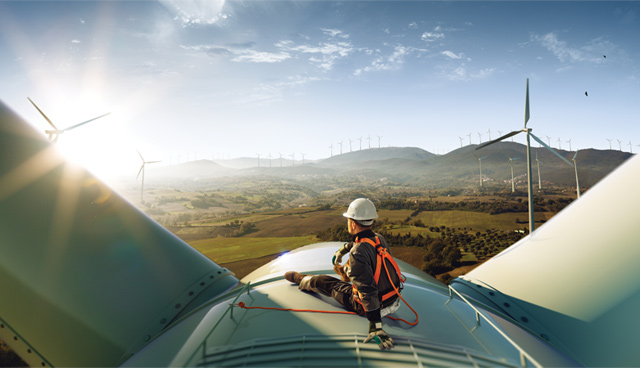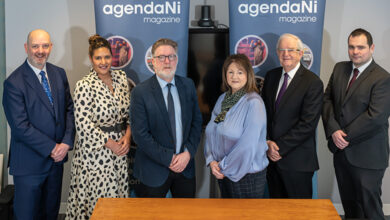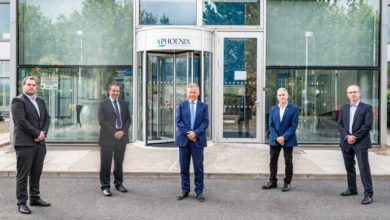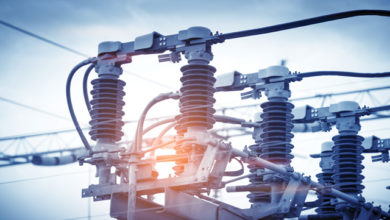Delivering a cleaner energy future

SONI, the Electricity System Operator for Northern Ireland, hosted a digital round table discussion with key stakeholders from across the energy sector focusing on the role of the power system in delivering a cleaner energy future.
What is the role of the electricity system in the decarbonisation of Northern Ireland’s economy?
David McGowan
The electricity system is going to be central to the energy transition. The Economy Minister’s ambition for a renewable electricity target of no less than 70 per cent is a gamechanger. As part of our role in planning the grid – we produce scenarios as pathways to decarbonising the power system. Through this research called Tomorrow’s Energy Scenarios, we anticipate that a 70 per cent renewable electricity target could reduce carbon emissions by two-thirds. That’s a significant reduction of CO2 intensity just by setting that policy in place and further enables electricity to become that sector coupling element to help transition those more difficult challenging economic areas such as heat and transport.
However, it’s a massive technical task. The Department for the Economy (DfE) Call for Evidence Paper set electricity use at about one fifth (17 per cent) of our energy needs in our homes and businesses today but if we look forward to 2050, it’s estimated that could rise to be as much as 50 to 60 per cent of our overall energy need. The deliverability of this is a huge technical challenge and will require collaboration across industry and with a broad range of stakeholders to ensure that we can realise the shift towards a net zero economy to support industry and consumers.
Steven Agnew
The power system has a huge role to play. Electricity has been a success story to date with emissions reductions of around 50 per cent from 1990 levels, however, we’ve yet to turn that corner in heat and transport. Prior to Covid-19, transport emission had increased by 5 per cent and heat emissions by 3 per cent since 2001, so power is doing the heavy lifting in terms of decarbonisation. That’s set to continue and it’s recognised that to reach net zero carbon by 2050, the power sector must fully decarbonise by 2040, meeting increasing electricity demand as those other sectors look to electrification as their means to decarbonise.
Sam McCloskey
While the role of the electricity system for decarbonisation of the economy cannot be underestimated, I think it’s important that we recognise that responsibility cannot lie with power generators and operators alone. We as individuals and those large energy users need to take on some of the responsibility. To aid with this, the Department for Business, Energy and Industrial Strategy (BEIS) recently released the Industrial Energy Transformation Fund to support energy efficiency measures and industrial decarbonisation. It’s available in Northern Ireland but hasn’t yet had strong uptake here, but it’s a great opportunity for organisations to decarbonise and to feed back in data to inform future mechanisms. Another point I would make is around the need for a better energy mix on the system. 48 per cent of electricity from renewables on the grid is a fantastic achievement but going forward we’re going to have to need a greater mix of electricity generation.
Tanya Hedley
The grid exists to provide a service that customers pay for. We have to be mindful of the impact of anything we do on consumers and the affordability of those actions. Putting all the cost of decarbonising electricity solely on to electricity bills doesn’t make sense to me because you then create cost in an area where you want people to move to. Collaboration is also important. A cultural change has begun but more work is needed to engage further with consumers to establish their needs and outline what options are available. Customers have to be at the centre of the transition but we also have to recognise that even those that don’t engage can’t be left behind.
Behavioural patterns and how individuals engage with energy is going to change. As we move towards new renewable technologies generating electricity, data transparency and how that data is shared will be important to allow people to be more creative in delivering solutions that will make a difference.
What level of adaptation will be required of the grid if it is to meet the changing requirements of future generations and technologies?
David McGowan
In transforming the grid we need to move from a 1,600MW renewable system today to around 3200MW in 2030. In our forecasts, the range is somewhere between 1.8-2.8GW at peak, so we will potentially have more installed capacity than we have demand to supply. That’s where things like interconnection, battery storage, alternative fuels etc, can add to the mix and there are new opportunities for industry to do that.
The grid needs to be strengthened for resilience and to facilitate the energy produced by renewable technologies to be delivered to the market and to the consumer. However, there is a short time horizon in which a lot of solutions will need to be delivered and that’s where collaboration will be vital. We need to learn from the lessons of the last decade of how we can more effectively use our existing asset and minimise the build of new infrastructure. What infrastructure we do bring must be the right infrastructure for the years ahead and that’s where engagement with industry will be important.
“We need to learn from the lessons of the last decade of how we can more effectively use our existing asset and minimise the build of new infrastructure. What infrastructure we do bring must be the right infrastructure for the years ahead and that’s where engagement with industry will be important.”
— David McGowan, Team Lead, Future Network, SONI
The North South Interconnector is critical. An increase of 900MW transfer north and south is the equivalent of enough electricity to power 60,000 homes across the island and needs to be in place if we are to meet the Minister’s no less than 70 per cent target. Additionally, to reach net zero, we’d like to see that 500MW of offshore wind potential realised. At SONI we’re well positioned to work collaboratively with stakeholders to understand the potential for offshore wind. We need to understand the barriers and start developing solutions that help deliver a grid development framework, so that we can have the timely delivery of new assets.
Tanya Hedley
There has been a huge cultural change in how consumers interact with the grid and further adaptation will be required as the transition continues. The original grid concept was three large power stations providing all of the electricity and a general assumption that demand would be met at all times. Now, we are seeing self-generation and desire to sell excess generation. It’s becoming a two-way street and in the past SONI only spoke to generators but more visibility and more engagement is required of NIE and SONI in how this system works and works effectively for consumers. If this relationship doesn’t work well and there is no progressive thinking then costs are going to increase. We’re lucky in that Northern Ireland is small and we have those well-established relationships and understanding of systems. This can be an opportunity to establish ourselves as world leaders in delivering for consumers. I’d also emphasise the need for the North South Interconnector. It makes economic sense and is an investment that we are keen to see happen because we know it will reduce costs for consumers.
Sam McCloskey
The Matrix Sustainable Energy Horizon Panel Report, while an old report from 2013, carried the headline that Northern Ireland has an opportunity to be a leader in intelligent energy systems. Our constrained grid presents an opportunity for us to not be fast followers but to take the lead on innovation and do things differently. If we don’t start to move on some of these innovations to increase the energy mix or to capitalise on projects like the Girona ‘micro-grid’ project or some of the aspirations of the Kilroot Energy Park then we are destined to not make the most of this intelligent energy system opportunity.
Steven Agnew
There is a huge challenge in running a relatively small island grid system with limited interconnection. We are seeing levels of constraint and curtailment in Northern Ireland that are quite significant, with a cost to the industry of around £25 million in 2019, for example. That means fossil fuels coming on to the grid instead of clean renewable energy and in terms of carbon emissions, means an environmental cost as well.
It’s worth highlighting that on grid investment, not all costs end up with the consumer. The renewables industry has invested millions in cluster substations and in some cases our members pay for a substation that others will later connect to with no option for rebate. It is a collaborative approach, costs are shared between industry and the consumer and as an industry we stand ready to invest further and to work in partnership with stakeholders to help reach that tremendous ambition of 95 per cent renewable penetration on the grid by 2030.
Tanya Hedley
The substation clustering policy is a good example of where Northern Ireland has stepped outside of what others have done and delivered successfully. It was unique to Northern Ireland and I believe has been directly responsible for us achieving the level of renewable generation that we have. Consumers provided the security for that to develop and took on some of the risk. The Utility Regulator considered that risk as small leading to a proven effective decision because those clusters have subsequently filled as generators have seen the capacity and sought to utilise it.
What are the enablers of enhanced infrastructure and renewable technology investment?
Sam McCloskey
The two main enablers are research and development to establish technologies and then ensuring policy to support for emerging technologies from that research. By way of example of some ongoing research and development in Northern Ireland, some of the projects CASE are funding to support renewable technologies and develop support services include the use of building façade envelopes for cost effective community heat and power, floating solar technology, the creation of a layered GIS map to look at decarbonisation of heat opportunities in rural areas and tidal energy technology. Incentive to support renewable energy is currently lacking in Northern Ireland but even when we do move towards a new incentive, there is a strong lobby for an innovation Contracts for Difference (CFD), to support those technologies that can’t currently punch their weight and compete in price against offshore wind (for example at £40MW/hr). This will ensure that new technology will be an important part of the overall energy mix.
“Policy will be very helpful in terms of transmission investment. We want to enable investment, especially when there is a clear business case but we’re not policy makers and so a direction from government is something we look forward to.”
— Tanya Hedley, Director of Networks, Utility Regulator
Tanya Hedley
Wind, when first deployed, was substantially more expensive than it is now. The government support mechanism created the onshore wind industry to the point where it now functions without support. Support is needed for other emerging technologies to get them off the ground and the Government must ensure that they get this right through a competitive process. In developing the Energy Strategy the DfE has engaged with all stakeholders and so the outcome should be something that we are all pleased with given our role in developing it. Policy will be very helpful in terms of transmission investment. We want to enable investment, especially when there is a clear business case but we’re not policy makers and so a direction from government is something we look forward to.
Steven Agnew
We need our planning system to facilitate the energy transition and green recovery. We’ve reached almost 50 per cent renewable electricity generation but unfortunately some of the signals, particularly from the planning system, are ‘50 per cent and no more’. If we want to achieve the 70-80 per cent target by 2030, we need to work at all levels from the top of government through to our communities to sell the transition.
On the mechanism, our recent report ‘The Power of Renewable Electricity: A route to 80 by 30’ we explored the different options of a support mechanism. What we found was that in looking at the use of CfD in Great Britain and the RESS auctions in the Republic of Ireland, both would do what’s required to incentivise the next wave of renewables. It’s clear that the CfD pathway would be the easiest because the legislation already exists to do it but in both scenarios there would be a requirement for a Northern Ireland-specific pot to ensure technologies are competitive and that consumers only pay for build out in Northern Ireland.
David McGowan
Other areas of the energy market must also be considered, such as system services, which must be competitive going forward. From SONI’s perspective we look at the operability of the system and the scarcities that enable us to operate the system safely and securely so that energy is available to homes and businesses every hour. System services is a revenue stream that helps us operate that system in that manner. On infrastructure, we need strong energy policy. The net zero target exists but we need a strategy in place at local level to offer long-term certainty and short-term goals that are agile enough to unlock the cost savings. Offshore wind in the UK has dropped to £50 per MWh and we need to make sure we are not locking out technologies that may become economically viable going forward. Strong policy also helps us bring forward our business case to the regulator on developing out grid infrastructure.
Tanya Hedley
Things like CfDs are de-risking projects, reducing costs to the investors. I’m not saying that’s a bad thing but I am highlighting that consumers are underwriting that risk. So, those reduced costs need to be seen to be going through to the consumer. We need to be clearer on feeding through to consumers why we’re doing this and what the benefits are. The same applies for system services. System services costs are currently increasing and we know there is a requirement for that if we are going to move forward to 70-80 per cent penetration but we have to be able to show consumers that these clear and easily identified cost increases are creating value.
How can community acceptance of infrastructure and renewable technology be achieved?
Steven Agnew
It needs to be a collaborative approach. The industry, when it does build out projects, will provide community benefit schemes. Currently the industry pays approximately £2 million per year directly into communities in Northern Ireland and there are the added benefits of wider economic investment including jobs. However, at the minute it’s being left for industry and communities to work this out for themselves and I think there are lessons to be learned from the Scottish model, a much more collaborative approach between government, industry and communities or RESS in Ireland which has created a community pot. This facilitates communities to really buy-in, not just receiving renewable energy but also producing it. This transition does need to be a just one and the benefits of renewables must be shared but I don’t think government can continue to sit back.
“Our constrained grid presents an opportunity for us to not be fast followers but to take the lead on innovation and do things differently.”
— Sam McCloskey, Director, CASE
Sam McCloskey
I agree that better management is needed on the incentivisation side. Communities are and can feel real benefits through engaging in the transition. That’s the carrot approach. The other approach is that of the stick and we’ve seen through the UK’s recent announcement of the ban of petrol and diesel cars by 2030 how decisions can be made that simply have to be accepted. Achieving community acceptance will require a wide range of measures. However, it’s also worth commending the levels of engagement that have occurred in recent years by SONI, NIE and DfE through stakeholder consultation exercises. I don’t think any part of the community grouping will be left out by the time we have a new strategy.
Tanya Hedley
Clarity of message is important. It’s not just wind farms that have had to engage with communities, SONI and NIE have been very aware of the need to engage on their infrastructure and what value it brings to communities. I don’t think the new Energy Strategy will hold any surprises given the level of engagement that has and is occurring but, when the strategy is finalised it needs to articulate its impact in terms of greater levels of infrastructure and the impacts on consumer bills.
David McGowan
If we are looking to deliver a cleaner energy future then the hearts and minds of people in Northern Ireland must be central to everything that we do. Transparency is very important and it’s up to us to inform as best we can around the reasons for and impacts of the transition. At SONI, community engagement is at the heart of what we do but we need to be setting our award-winning standards for engagement at an even higher level as we move forward and we are constantly reviewing our processes on how we engage and interact with communities because without people understanding what we need to do and without public support we have very little chance of delivering on our ambitions.
“Cost analysis is important because we do have a climate crisis that we have to address and because there is a much larger cost in doing nothing, environmentally and in terms of our wellbeing and way of life.”
— Steven Agnew, Head, RenewableNI
Steven Agnew
Cost analysis is important because we do have a climate crisis that we have to address and because there is a much larger cost in doing nothing, environmentally and in terms of our wellbeing and way of life. If we don’t decarbonise the power system now then we’re looking at much higher costs for huge engineering solutions to deliver carbon capture and storage (CCS) for carbon-producing industry later, which would be a waste of consumers’ money. Green technology is on our doorstep, so let’s utilise it to deliver the cheapest forms or electricity for the consumer and for the planet.
What is the priority requirement of the Northern Ireland Energy Strategy in delivering a cleaner energy future?
David McGowan
We need that political courage for a transformational policy. The Minister has acknowledged the ambition of not less than 70 per cent renewables on the system by 2030. That’s a visionary approach. Let’s get it in place and move forward.
Sam McCloskey
There is a lot of ongoing innovation in delivering a cleaner energy future. A framework will provide that overarching strategy direction but with a delivery timescale at the end of 2021 we must continue to make progress in the meantime. We punch well above our weight in Northern Ireland in terms of renewables but we’re modest about it. I think Northern Ireland should consider developing a 10-point plan decarbonisation plan similar to that announced by Boris Johnson in November 2020.
Tanya Hedley
I believe we are getting on with things. There are areas of ‘no regret’ which we now need to see happen and both NIE and SONI are currently actioning things that will feed in to the Strategy and we’re doing what we can to get as many building blocks in place so that we can continue progress in the Strategy’s direction. For me, the priority of the Energy Strategy is communication. The big picture needs to be presented and a clear message on what is going to be delivered and what the associated costs are for the consumer.
Steven Agnew
I think the priority is deliverability. I am confident we are going to get a very ambitious Energy Strategy but what I’m not confident of is the ability to realise that ambition. Right now we have a Department for the Economy stating its desire to advance the decarbonisation agenda but we have a planning system that says no we don’t. We need those things to align and we need joined-up government, at all levels, if we are to deliver on our ambitions.
Round table participants
Steven Agnew
Steven is Head of RenewableNI, the representative body for the renewable electricity sector in Northern Ireland. He previously served for eight years as MLA for North Down during which time he chaired the All Party Group on Renewables and sat on the Enterprise, Trade and Investment Committee.
Tanya Hedley
Tanya is Director of Networks at the Utility Regulator in Northern Ireland and is responsible for all regulation of electricity, water and gas networks in Northern Ireland. Prior to this she held the roles of Director of Compliance and Network Operations, Director of Water Regulation and Director of Electricity Regulation at the Utility Regulator. Prior to joining the Utility Regulator, Tanya worked for NIE for over 18 years in Transmission Development, Asset Management and Environmental Management. Having completed a degree in Electrical and Electronic Engineering she gained Chartered Engineer status. She is also a Fellow of the Institute of Engineering and Technology and an Associated Member of the Institute of Environmental Management and Assessment.
Sam McCloskey
Sam joined CASE in November 2012 following an 18-year career in consultancy. She calls upon broad ranging experience of leading energy, sustainability, resource efficiency and R&D projects across a number of industry sectors, from local to pan-European. As a member of the NI MATRIX government science advisory panel for sustainable energy, she was intrinsically involved in the development of a Road Map for sustainable energy to 2035. She is a Fellow of the Energy Institute.
David McGowan
David is a team lead in Future Network with SONI where his responsibilities lie in energy economics. He was previously a Senior Lead Engineer with the organisation and helped develop the business case analysis for the North South Interconnector and the Celtic Interconnector. He studied Electrical and Electronics Engineering at Queen’s University Belfast before completing a PhD in the same subject.






